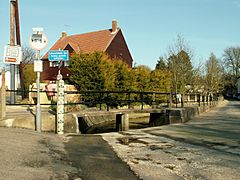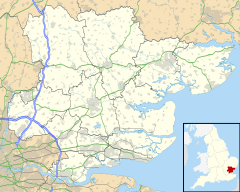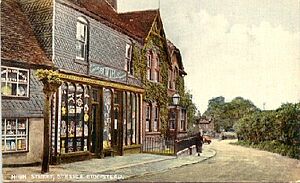Steeple Bumpstead facts for kids
Quick facts for kids Steeple Bumpstead |
|
|---|---|
 The footbridge on the corner of Church Street, Steeple Bumpstead |
|
| Population | 1,627 (2011) |
| OS grid reference | TL6841 |
| Civil parish |
|
| District |
|
| Shire county | |
| Region | |
| Country | England |
| Sovereign state | United Kingdom |
| Post town | HAVERHILL |
| Postcode district | CB9 |
| Dialling code | 01440 |
| Police | Essex |
| Fire | Essex |
| Ambulance | East of England |
| EU Parliament | East of England |
| UK Parliament |
|
Steeple Bumpstead is a village and civil parish about 3 miles (5 km) south of Haverhill in the Braintree area of Essex, England.
Even though its name includes "Steeple," the main village church does not have a steeple. However, the Congregational Church in the village has a small steeple built during the Victorian era. People believe the original steeple that gave the village its name was located near what is now the Wixoe Pumping Station.
The village has several useful places like a village hall, a primary school (Steeple Bumpstead Primary School), and a park.
Contents
Understanding the Name: Steeple Bumpstead
The name Bumpstead used to refer to the whole area, including what is now Steeple Bumpstead and Helions Bumpstead. The name first appeared in old documents around 1042.
Historians believe the first part of the name, Bumsted, comes from an old English word, bune. This word likely meant 'reeds', which are tall grasses that grow in wet places. This makes sense because a river with many reeds runs through Steeple Bumpstead. The second part, stede, means 'place', or hām-stede, meaning 'homestead'. So, the name Bumpstead probably meant 'reed-place' or 'homestead on the River Bune'.
Over time, two main areas grew. The Helions part became known as Bumpstead Magna (Great Bumpstead), and the Steeple part became Bumpstead Parva (Little Bumpstead). The "Steeple" part of the name came from a church tower that was there. Old records from the late 1200s mention "Stepilbumstede" or "Bumpstead at the tower."
A Look Back: History of Steeple Bumpstead
The Knights Templar, a famous group of medieval knights, once had a presence near the river in this area. The village is also known for its connections to the Lollards, who were people in the 14th and 15th centuries who wanted to change the church.
There's a long history of people in the village holding different religious beliefs, known as non-conformists. This tradition continues today at the Congregational Church. A man from Bumpstead was sadly executed for his beliefs in the past. There's a field called 'Bloody Pightle' along Blois Road, where he is thought to have died. In 1527, John Tibauld and eight other villagers were taken to the Bishop of London. They were accused of meeting at Bower Hall to pray and read a copy of the New Testament. Even though a powerful local family, the Bendyshes, supported the non-conformists, they couldn't save Tibauld.
Bower Hall, a large house, was later used for other purposes during the First World War. It fell into ruin and was taken down in 1926. Some parts of it, like a grand staircase, were even moved to the United States.
The Moot Hall, also called "the Old Schole," is a very important building in Steeple Bumpstead. It was built in 1592 by the villagers on land they rented. In the 1830s, when it was a school for farmers' sons, the villagers fought to keep control of it. They disagreed with a local landowner who claimed the right to choose the headmaster. In the end, a church court agreed with the villagers.
Steeple Bumpstead Today
Steeple Bumpstead has many places for its residents. These include a local village shop, a post office, a petrol station, and a library located in the historic Moot Hall. There are also two pubs: The Fox and Hounds and The Red Lion.
The village has two churches: the Church of England parish church of St. Mary's and the Congregational Church. Both offer different activities for people of all ages. St Mary's is a very old building, dating back to the 11th century, and is considered a Grade I listed building, meaning it's very important historically.
Steeple Bumpstead also has its own primary school, Steeple Bumpstead Primary School.
For young people, there is a Scout Group, the 1st Steeple Bumpstead Scouts. This group includes a Beaver Colony (for younger kids), a Cub Pack, and a Scout Troop (for older kids).
The village has even been mentioned in popular culture! It appears in the first pages of the 2007 novel The Reavers by George MacDonald Fraser. It was also mentioned in an episode of the 1976 BBC TV show The Fall and Rise of Reginald Perrin.
Famous People Connected to Steeple Bumpstead
Nurse Edith Cavell had a connection to Steeple Bumpstead long before she became a famous nurse. In 1886, Edith worked as a governess for the four children of Reverend Charles Powell, who was the vicar of Steeple Bumpstead. The old vicarage, where she lived, is now a private home. There is a stone plaque there to remember her stay. You can also find a plaque about Edith Cavell in the 11th-century village church, and a road in the village is named after her.
Colonel J. C. Humphrey, whose father was a wheelwright in the village, was once thought to have invented corrugated iron. However, this is a myth, as it was actually invented by Henry Robinson Palmer in 1829. Colonel Humphrey built and lived in a house called the Iron House on North Street, which was taken down in the 1960s. His company, Humphreys Ltd of London, was once very large and supplied goods to King Edward VII.
See also
In Spanish: Steeple Bumpstead para niños



